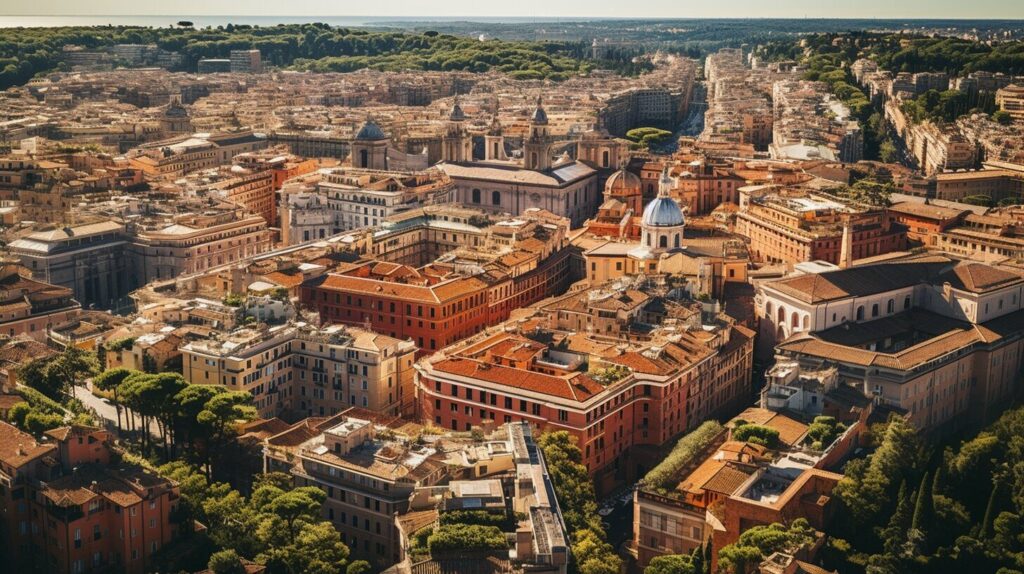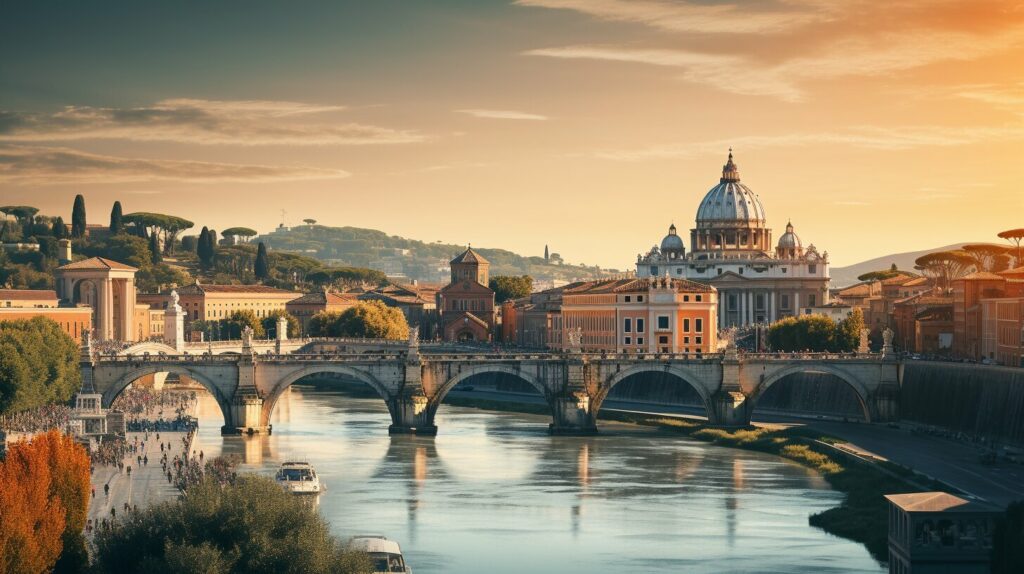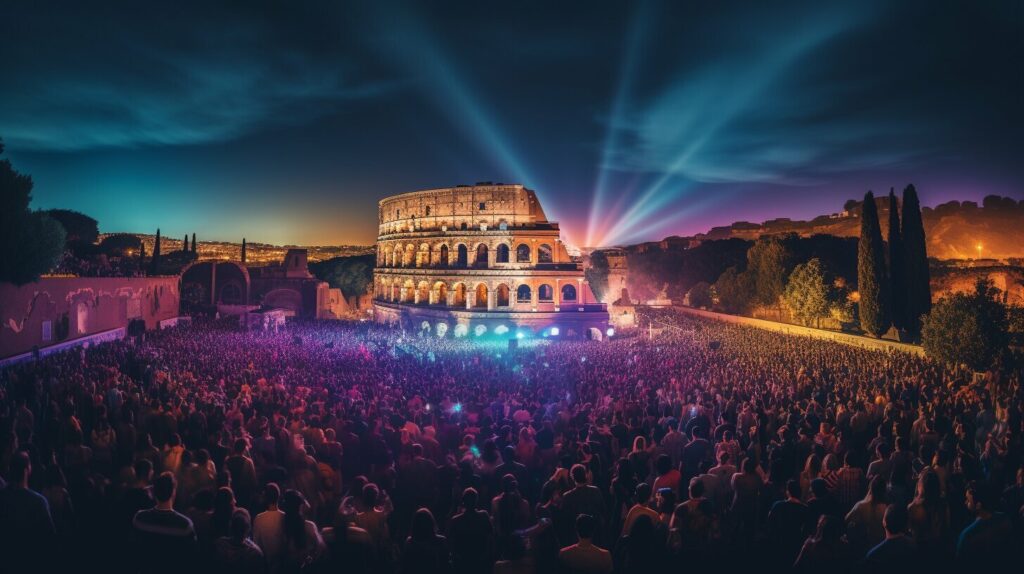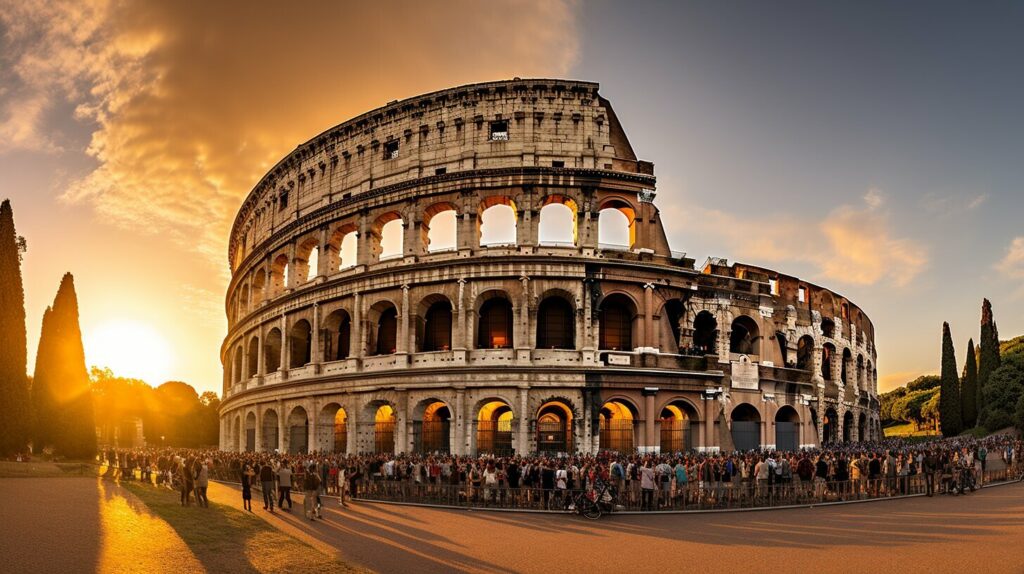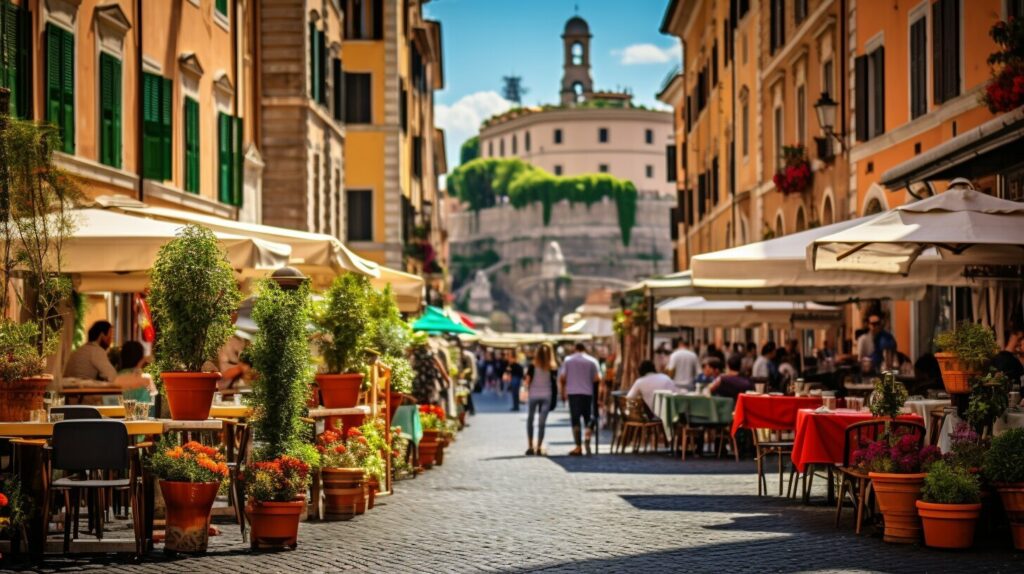Rome is a city that needs no introduction. Its stunning architecture, rich history, and delicious cuisine draw millions of visitors every year. But beyond the iconic landmarks and tourist hotspots lies a world of hidden gems waiting to be discovered.
Exploring Rome’s hidden gems offers a unique perspective on the city, allowing you to uncover secret spots and experience its authentic charm. From fascinating viewpoints to tranquil parks and off-the-beaten-path neighborhoods, the Eternal City has plenty of surprises in store for those willing to venture off the tourist trail.
Key Takeaways:
- Discover the secret spots that make Rome a truly unforgettable destination.
- Explore hidden gems like the Aventine Keyhole, Quartiere Coppedè, and Villa Doria Pamphilj.
- Indulge in artisanal gelato, visit a former power plant-turned-museum, and explore Rome’s charming bohemian quarter.
The Aventine Keyhole: Discover Rome’s best-kept secret
When it comes to hidden gems in Rome, the Aventine Keyhole is a must-see attraction that is guaranteed to leave you in awe. Located on top of the Aventine Hill, this unassuming keyhole offers a view like no other – a perfectly framed vista of St. Peter’s Basilica through a lush green garden.
To find the Aventine Keyhole, head to the Piazza dei Cavalieri di Malta and look for the large wooden door at the end of the square. As you peer through the keyhole, you’ll be treated to an incredible sight that seems almost too perfect to be real.
The keyhole is located within the priory of the Knights of Malta, a religious order that has been in Rome since the 12th century. The garden you are peering into is their private garden and it sits on top of a hill which provides the perfect vantage point for this awe-inspiring view.
The Aventine Keyhole: A Window to the Heart of Rome
The history surrounding the Aventine Keyhole is almost as fascinating as the view itself. According to legend, the keyhole was used by the Knights of Malta as a lookout to defend against potential threats from the surrounding area. Over time, the keyhole became a symbol of their power and prestige in Rome. Today, it is a unique attraction that draws visitors from around the world.
“The view through the keyhole is truly magical, and it feels like a secret that only a select few know about. “
If you’re looking for a hidden gem in Rome that offers a unique perspective on the Eternal City, then the Aventine Keyhole is not to be missed. Whether you’re a history buff or simply looking for a breathtaking view, this attraction is sure to leave a lasting impression.
Villa Doria Pamphilj: Rome’s hidden green oasis
If you’re yearning for a break from the hustle and bustle of Rome’s busy streets, take a trip to Villa Doria Pamphilj. This hidden gem is a tranquil park located in the southwest of the city, boasting lush greenery and ancient ruins.
Stretching over 445 acres, the park offers a peaceful escape from the crowds, with its expansive gardens, shaded walking paths, and serene water features. Stroll through the park’s olive groves and fragrant rose gardens, and discover hidden corners like the Casino del Bel Respiro, adorned with frescoes and ornate furnishings.
But Villa Doria Pamphilj isn’t just a pretty sight. As the remnants of a once-grand estate built in the seventeenth century, the park is also home to interesting historical sites. Venture to the top of the Janiculum Hill for a stunning view of the city, or explore the ancient Roman tombs and ruins hidden among the trees.
When you’re ready for a break, head to the park’s charming cafe for a refreshing drink or snack. And if you’re visiting on a Sunday, don’t miss the farmers’ market where you can sample local produce and artisanal goods.
Quartiere Coppedè: Art Nouveau charm off the beaten path
If you’re searching for an off-the-beaten-path experience, Quartiere Coppedè is a hidden gem that should not be missed. Tucked away in the Trieste neighborhood, this enchanting quarter is known for its Art Nouveau architecture and whimsical atmosphere.
Take a stroll through the labyrinthine streets and discover the neighborhood’s unique buildings, adorned with stunning mosaics and hidden courtyards. Designed by architect Gino Coppedè in the early 20th century, this area is a true feast for the eyes.
The Buildings of Quartiere Coppedè
One of the highlights of Quartiere Coppedè is the variety of buildings that can be explored. The Palazzo del Ragno, for example, is a neo-Gothic palace with a spider-shaped fountain in the courtyard. The Palazzina del Ragno, located nearby, is a smaller building with a facade embellished with frescoes.
Another notable building is the Villino delle Fate, which translates to “Little Fairy House.” This whimsical building features a tower covered in greenery, as well as sculptures of animals and mythical creatures.
Mosaics and Sculptures
One of the defining features of Quartiere Coppedè is the intricate mosaics and sculptures that adorn many of the buildings. Look out for the Fountain of the Frogs, a beautiful sculpture featuring frogs spitting water into a basin.
Also, be sure to stop by the House of the Owl, a stunning building with a mosaic owl perched above the entrance. The designs on this building and others in Quartiere Coppedè are a clear expression of the Art Nouveau style, making it a must-visit spot for architecture enthusiasts.
If you want to discover a secret and charming neighborhood in Rome, Quartiere Coppedè is the place to visit. Enjoy the unique atmosphere and stunning architecture that sets it apart from the rest of the city.
Basilica di San Clemente: Unveiling layers of history
If you’re looking to explore some of Rome’s hidden gems, be sure to add the Basilica di San Clemente to your list. This remarkable church may look unassuming from the outside, but once you step inside, you’ll discover multiple layers of history and architecture.
The first level of the Basilica di San Clemente is a 12th-century church, complete with stunning frescoes and intricate stone carvings. But that’s just the beginning. Venture down a narrow staircase to discover the second level, where you’ll find an even older church dating back to the 4th century.
As if that wasn’t enough, there’s a third level to explore. This level takes you all the way back to ancient Rome, where you can see the remains of a pagan temple and a Mithraic temple dedicated to the god Mithras. It’s a truly unique experience to see the layers of history all in one place.
“The Basilica di San Clemente is a must-see for history buffs and anyone interested in seeing a lesser-known side of Rome.”
Exploring the Basilica di San Clemente is a fascinating journey through time, and it’s a hidden gem that many visitors to Rome overlook. Don’t miss your chance to discover this incredible piece of history.
The Appian Way: Rome’s ancient road less traveled
When in Rome, take a step off the beaten path and explore the historic Appian Way. Built in 312 BC, this ancient road offers a glimpse into Rome’s rich history and breathtaking countryside.
Start your journey at the Porta San Sebastiano gate, where you can rent a bike and follow the trail at your own pace. Along the way, you’ll encounter impressive ruins such as the Circus of Maxentius, the Tomb of Cecilia Metella, and the Catacombs of San Callisto.
As you ride or walk on the ancient cobblestones, take in the serene surroundings of the Appian Way Regional Park. The scenic landscape is dotted with fields of wildflowers, vineyards, and olive groves.
Exploring the Appian Way
There are several ways to explore the Appian Way, but we recommend the following:
| Activity | Description |
|---|---|
| Bike rental | Rent a bike at Porta San Sebastiano and cycle along the Appian Way. |
| Guided tour | Book a guided tour to learn more about the history of the Appian Way and its surroundings. |
| Picnic | Pack a picnic and enjoy a leisurely afternoon in the Appian Way Regional Park. |
Visiting the Appian Way is a unique and unforgettable experience that allows you to escape the crowds of Rome and immerse yourself in the city’s rich history and stunning natural beauty. Don’t miss out on this hidden gem!
Gelateria del Teatro: Indulge in artisanal gelato away from the crowds
When it comes to gelato in Rome, there are plenty of options to choose from. But if you want to experience the best of the best, away from the tourist crowds, head to Gelateria del Teatro. Tucked away in a hidden corner near the Tiber River, this artisanal gelato shop is a true gem.
What sets Gelateria del Teatro apart from other gelaterias is its commitment to using only the freshest, locally-sourced ingredients. From seasonal fruits to organic milk and nuts, every flavor is crafted with care and attention to detail.
But the real magic happens when you take that first bite. Whether you opt for classic flavors like pistachio and hazelnut or more unique creations like ricotta and fig or white wine and peach, you’ll be transported to gelato heaven.
So next time you’re in Rome and need a break from the hustle and bustle of the city, make your way to Gelateria del Teatro. You won’t regret it.
Centrale Montemartini: Where Classical Art Meets Industrial Heritage
Located in the Ostiense neighborhood of Rome, Centrale Montemartini is a unique museum that combines classical art with industrial heritage. Housed in a former power plant, the museum features ancient statues and sculptures juxtaposed against the machinery and equipment of the early 20th century.
Unlike the crowded museums in the city center, Centrale Montemartini offers a peaceful and immersive experience for art lovers. Explore the vast collection of Roman and Greek sculptures, including the famous “Dying Gaul” and “Aphrodite of Cnidus.” Admire the intricate mosaics and frescoes that once adorned ancient villas and public buildings.
The museum’s industrial heritage is equally fascinating, with massive turbines, generators, and boilers on display. Learn about the history of electricity in Rome and the role of the Montemartini plant in the development of the city’s infrastructure.
To reach Centrale Montemartini, take the metro to Garbatella station and walk about 10 minutes. The museum is open from Tuesday to Sunday, 9 am to 7 pm. Admission is included in the Roma Pass or can be purchased separately.
Experience the captivating blend of classical art and industrial history at Centrale Montemartini – a hidden gem that should not be missed.
Trastevere: Rome’s charming bohemian quarter
Get lost in the winding streets of Trastevere, one of Rome’s hidden gems that exudes a bohemian style. This neighborhood, located on the banks of the Tiber River, is known for its vibrant nightlife, authentic trattorias, and lively piazzas.
Take a stroll through the neighborhood’s narrow cobblestone streets and admire the colorful facades of the buildings. Stop by Piazza di Santa Maria in Trastevere and marvel at the stunning Basilica di Santa Maria in Trastevere, one of the oldest churches in Rome.
Trastevere is also a great spot to sample traditional Roman cuisine. Head to Da Enzo al 29 for delicious pasta dishes or indulge in some of the best pizza in the city at Dar Poeta.
If you’re a street art enthusiast, be sure to check out the artworks scattered throughout the neighborhood. Trastevere’s bohemian spirit attracts many artists, making it the perfect location to discover some of the city’s most intriguing street art.
Trastevere is easily accessible by foot from the historic center of Rome. Cross the Ponte Sisto bridge and you’ll find yourself immersed in the charming and authentic atmosphere of this hidden gem.
Testaccio Market: Foodie heaven off the tourist path
If you’re a food lover looking to experience authentic Roman cuisine, look no further than Testaccio Market. Nestled off the tourist path, this hidden gem is a foodie paradise that offers a unique glimpse into the city’s culinary traditions.
The market is a bustling hub of local vendors selling fresh produce, meats, cheeses, and more. Take a stroll through the colorful aisles and explore the variety of traditional Roman dishes on offer.
Make sure to sample some of the market’s standout delicacies, such as supplì (fried rice balls with melted mozzarella), tripe (a classic Roman dish), and porchetta (slow-roasted pork). And don’t forget to pair your food with a glass of local wine or a refreshing Italian beer.
For those looking for a more immersive experience, Testaccio Market also offers cooking classes where you can learn to make your own homemade pasta or traditional Roman dishes.
What to know before you go:
Location: Via Beniamino Franklin, 00118 Rome, Italy
Hours of Operation: Monday-Saturday, 7am-3:30pm
How to get there: The market is accessible via public transportation; take the metro to Piramide station or buses 3, 60, 75, or 83.
Whether you’re a seasoned foodie or simply looking to experience the flavors of Rome like a local, Testaccio Market is a must-visit destination for any trip to the Eternal City.
Conclusion
Exploring hidden gems in Rome is a surefire way to create an unforgettable trip. From the stunning view through the Aventine Keyhole to the gastronomic delights of Testaccio Market, Rome’s hidden spots offer a unique and authentic experience away from the tourist crowds.
By venturing off the beaten path, you can discover the city’s bohemian spirit in Trastevere, witness the mix of classical art and industrial heritage at Centrale Montemartini, and indulge in artisanal gelato at Gelateria del Teatro.
Uncovering layers of history at Basilica di San Clemente and walking along the ancient Appian Way are experiences not to be missed, while Villa Doria Pamphilj provides a much-needed green oasis in the midst of a bustling city.
Quartiere Coppedè offers an enchanting escape into the world of Art Nouveau, complete with whimsical buildings and hidden courtyards.
So why not take the road less traveled and add a touch of adventure to your trip? Who knows, you may just stumble upon your own hidden gem in the Eternal City.
FAQ
Q: What are hidden gems in Rome?
A: Hidden gems in Rome are lesser-known attractions, neighborhoods, or experiences that offer a unique and memorable aspect of the city. They are often off the beaten path and provide a chance to discover a different side of Rome beyond the popular tourist sites.
Q: Why should I visit hidden gems in Rome?
A: Visiting hidden gems in Rome allows you to uncover the city’s secret spots, providing a more authentic and immersive experience. It allows you to explore lesser-known areas, discover local culture, and avoid the crowds that often flock to the popular tourist attractions.
Q: How can I find hidden gems in Rome?
A: To find hidden gems in Rome, it is helpful to do some research beforehand and seek recommendations from locals or travel guides. Exploring neighborhoods off the beaten path, seeking out unique attractions, or venturing away from the city center can often lead to discovering hidden gems.
Q: Are hidden gems in Rome safe to visit?
A: Hidden gems in Rome are generally safe to visit, just like any other part of the city. However, it is always important to exercise caution and be aware of your surroundings, especially when exploring lesser-known areas. It is advisable to take necessary precautions and follow any local guidelines or advice.
Q: Can I visit hidden gems in Rome with children?
A: Yes, many hidden gems in Rome are suitable for visiting with children. However, it is important to check the specific attractions or areas beforehand to ensure they are child-friendly. It is also recommended to plan accordingly and consider the interests and needs of your children when exploring hidden gems.
Q: How much time should I allocate for visiting hidden gems in Rome?
A: The amount of time needed to visit hidden gems in Rome depends on the specific attractions or areas you plan to explore. Some hidden gems may require only a few hours, while others may take a half-day or more. It is best to plan ahead and allocate enough time to fully enjoy and explore each hidden gem.
Q: Are hidden gems in Rome expensive to visit?
A: Hidden gems in Rome can vary in terms of cost. Some hidden gems may have free admission, while others may require a fee or have additional costs associated with them. It is advisable to check the specific attractions or areas beforehand to understand any associated costs and plan accordingly.
Q: Can I visit hidden gems in Rome without a guide?
A: Yes, it is possible to visit hidden gems in Rome without a guide. However, having a guide can be beneficial as they can provide valuable insights, historical context, and local knowledge about the hidden gems. It ultimately depends on personal preference and the level of information and guidance you wish to have during your visit.
Q: Are hidden gems in Rome accessible for people with disabilities?
A: Accessibility may vary for different hidden gems in Rome. Some attractions or areas may have specific facilities or accommodations for people with disabilities, while others may have limitations. It is advisable to check the accessibility information of each hidden gem beforehand and plan accordingly.
